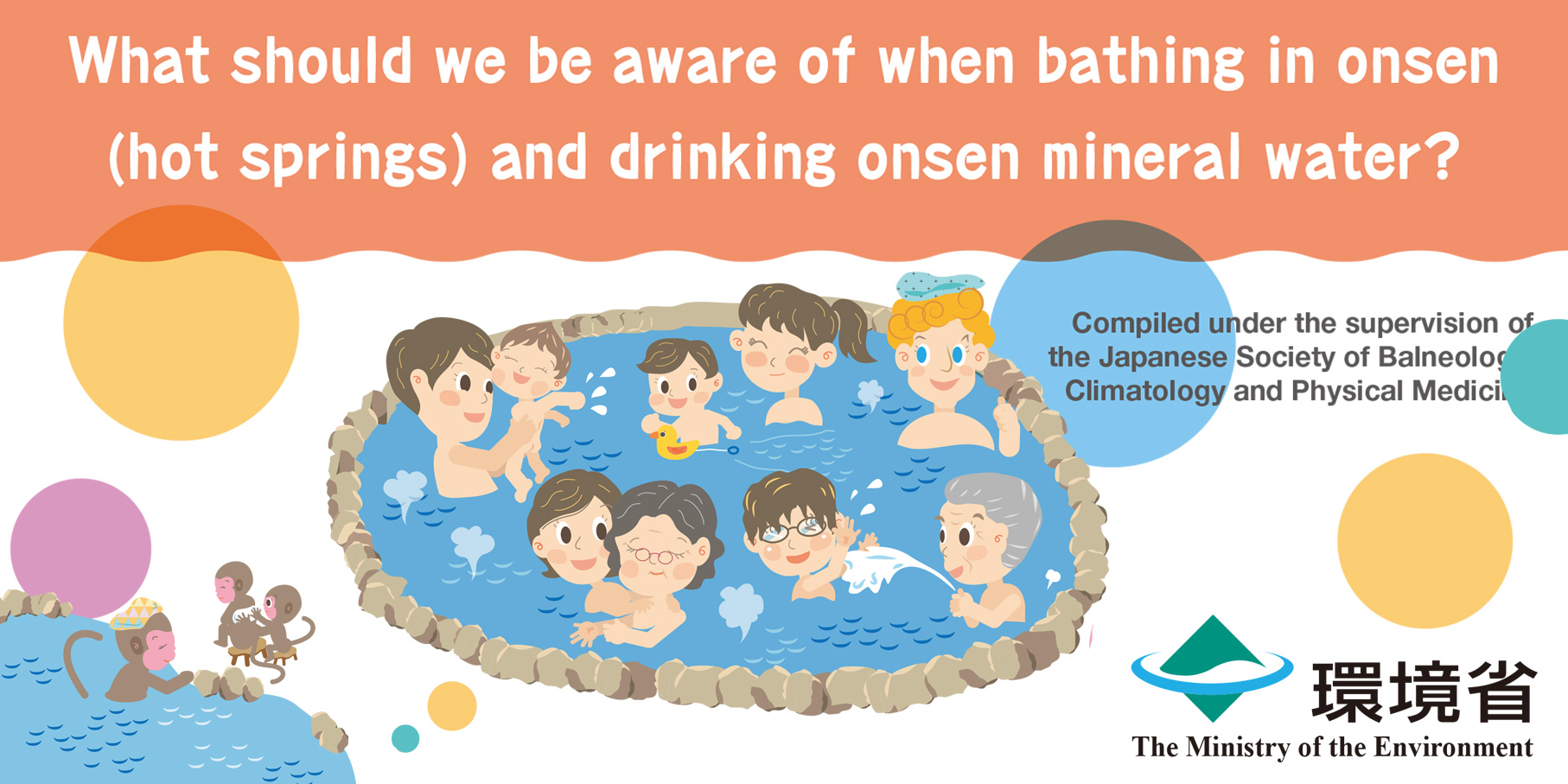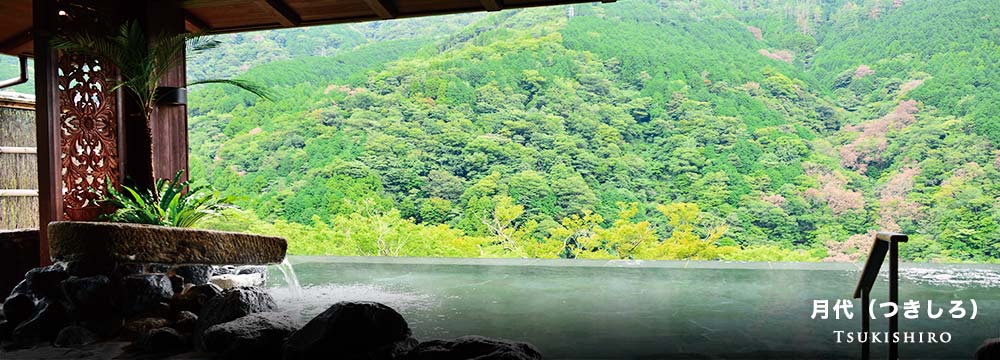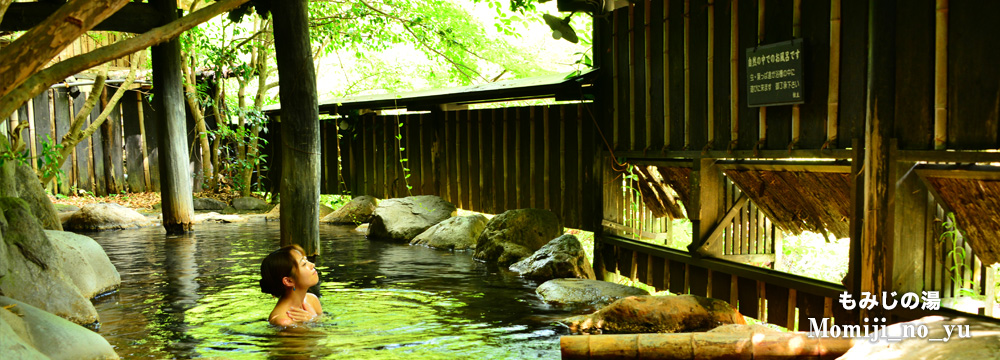
FUMOTO RYOKAN
| Sodium, Calcium - Hydrogen carbonate / Sulfate / Chloride springs | pH |
|
| ナトリウム・カルシウム-炭酸水素塩・硫酸塩・塩化物泉 | ||
| (Hypotonic, Neutral, High temperature Springs) | ||
| 旧泉質名:含石膏・塩化土類-重曹泉 | ||
Ideal for people like this
- Who want to test the skin beautifying effect
- Who have dry skin
- Who want to treat cuts quickly
- Who are feeling stressed
- Who have sensitivity to cold
- Who want to feel refreshed after bathing
- Address
- 6697 Manganji, Minami-Oguni machi, Aso-gun, Kumamoto, 869-2402, JAPAN
- TEL
- +81-(0)967-44-0918

Official Website

Travel Journal
Hot Spring Power Chart (5-point scale)
Hydrogen Ion Concentration (pH)

- Comment
- Hot spring for beautiful skin that combines three types of spring quality
Hot spring Specification
※This is an easy-to-understand expression based on the indications for each type of spring in the "Guidelines for the Mineral Spring Analysis Methods" revised in July 2014 by the Ministry of the Environment.
| ①Mental recovery | ②Insomnia | ③Promote blood circulation | ④Sensitivity to cold | ⑤Dry skin |
| ⑥Cuts | ⑦Skin diseases | ⑧Hypertension (mild) | ⑨Heartburn (drinking) | ⑩Gastrointestinal disorders (drinking) |
| ⑪Constipation (drinking) | ⑫Lifestyle-related disease | ⑬Diabetes | ⑭Gout | ⑮Countermeasures against metabolic syndrome |
| ⑯Biliary system anxiety (drinking) | ⑰Anaemia | ⑱Arthritis rheumatica | ⑲Spinal pain | ⑳Improved immunity |
| ㉑Muscle pain・Neuralgia | ㉒Mild asthma | ㉓Hemorrhoidal pain | ㉔Recovery from an illness | ㉕Recovery from fatigue |
- ※Note①・・・Indications for each spring include autonomic instability and depression.(Simple springs・Chloride springs・Carbon dioxide springs)
- ※Note③・・・Indications for each spring include peripheral circulatory disturbance(Chloride springs・Carbonate springs・Carbon dioxide springs・Hydrogen sulfide type sulphur spring)
- ※Note④・・・Indications for each spring include sensitivity to cold (Chloride springs・Carbonate springs・Sulfur springs・Carbon dioxide springs) and Iron containing springs
- ※Note⑦・・・Indications for each spring include xeroderma, atopic dermatitis, plaque psoriasis, epidermoid suppuration, chronic eczema (Chloride springs・Carbonate springs・Sulfate spring・Acid springs・Sulfur springs)
- ※Note⑨・・・Indications for drinking each spring include reflux esophagitis (Carbonate springs)
- ※Note⑩・・・Indications for drinking each spring include atrophic gastritis, gastroduodenal ulcerations (Chloride springs・Carbonate springs)
- ※Note⑪・・・For drinking, Chloride springs and Sulfate spring
- ※Note⑫・・・Indications for each spring include hypercholesterolemia, diabetes, gout (for bathing, Acid springs・Radioactive springs/for drinking, Carbonate springs・Iodine containing springs・Sulfur springs)
- ※Note⑮・・・Indications for drinking each spring include hypercholesterolemia (Sulfate spring・Iodine containing springs・Sulfur springs)
- ※Note⑱⑲・・・Indications for each spring include rheumatoid arthritis, ankylosing spondylitis(Radioactive springs)
- ※Note⑳・・・Radioactive springs
- ※Note㉑㉔・・・Simple Springs is suitable for rehabilitation due to its low irritation, and is also called "Hot spring for Neuralgia" and "Hot spring for Stroke", although these are not listed as indications by spring quality.
| Applicable to indications by spring quality | Applicable to general indications |
7 Elements of Hot Springs for Beautiful Skin
Total4Points ※The number of points represents the quality of the "Hot spring for Beauty".
| Skin cleansing effect | Skin reviving effect | Skin whitening effect |
|---|---|---|
| Hydrogen carbonate springs | Sulfate springs | Sulfur springs |
| Skin smoothing effect | Skin coating and moisturizing effect | Skin moisturizing effect | Cleaning effect |
|---|---|---|---|
| (Weak) Alkaline springs | Chloride springs | Metasilicic acid(more than 100mg/kg) | Metaboric acid(more than 10mg/kg) |
- ※The "Four Best Beauty Springs" are said to be "Carbonate spring", "Sulfate spring", "Sulfur spring", and "(Weak) Alkaline simple hot spring".
- ※The "Chloride spring" coats the skin with a salt pack, keeping it warm and moisturized at the same time. It is also called "hot spring for finishing touch" to be taken after the "hot spring for beauty" in which exfoliation has been removed.
- ※Hot springs containing 100 mg/kg or more of metasilicicic acid have an excellent moisturizing effect and is said to be "hot spring for beauty".
- ※Hot springs containing 10 mg/kg or more of metaboric acid have a cleansing effect, is used in some eye drops, and is said to be effective in treating acne.
Water texture while bathing(5-point evaluation)
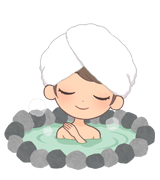
| Smoothly | Mushy | ||||||||||
|---|---|---|---|---|---|---|---|---|---|---|---|
| Powdery | Chewy | ||||||||||
| Fizzy | Tingling | ||||||||||
Skin feeling after bathing(5-point evaluation)
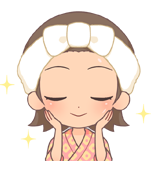
| Silky | Dryness | ||||||||||
|---|---|---|---|---|---|---|---|---|---|---|---|
| Powdery | Sticky | ||||||||||
| Moistly | Warmly | ||||||||||
View from the open-air bath (5-point evaluation)
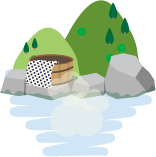
| Surrounded by bamboo trees, enjoying the feeling of soaking in an open-air bath deep in the mountains. |
| Women's Open-air Bath "Uen-Yu" |
| Point 4 |
|---|
Hot Spring Source Usage
| Water added No |
Heated No |
Disin fected No |
Circulated No |
Bath additive No |
|---|---|---|---|---|
| ○ | △ | ○ | ○ | ○ |
| ※All bathtubs are 100% free-flowing hot spring water ※In winter, the temperature is kept at a suitable level for bathing by exchanging heat with the shared source of Kurokawa Onsen (higher temperature) |
||||
| Percentage of hot spring source |
100% | ||||
|---|---|---|---|---|---|
| Replacement frequency of hot spring water | Once a day | ||||
| Yield of hot spring water |
Power-pumped hot spring drawn from 300 m underground | ||||
| Distance from the source to the bathtub |
About 700m (hot water piped from sister inn "Kounoyu") | ||||
| How hot spring water is drawn | Drawn by pipe | ||||
| Temperature adjustment | Adjustment of hot water volume | ||||
| Drinking spring | Cannot | ||||
| "Gensen-Kakenagashi" Bath | Large public bath (open-air bath) x 2, Private bath (including open-air bath) x 11, Guest room open-air bath x 3, Footbath x 1 | ||||
Hot Spring Composition TableHot Spring Analysis Report
| Spring Quality | Sodium, Calcium - Hydrogen carbonate / Sulfate / Chloride springs(Hypotonic, Neutral, High temperature Springs) 旧泉質名:含石膏・塩化土類-重曹泉 |
|---|---|
| Color of hot spring | Colorless to Pale green |
| Scent of hot spring | Mild hydrogen sulfide odor |
| Dissolved substances | 1,180mg/kg (Sum of components (1) + (2) + (3), excluding gaseous substances) |
| Temperature of spring | 60.5℃ (9.1℃ at the time of the survey) |
| pH | 6.4 (Neutral) |
| Yield | Unclear ※The requirements to satisfy kakenagashi (flowing directly from the source) and amount of hot spring required for bathtub management are more than 1 liter/minute per person who enters the bathhouse (cited from "Gensen-Yuyado"). |
Hot Spring Composition (Amount contained in 1 kg of spring)
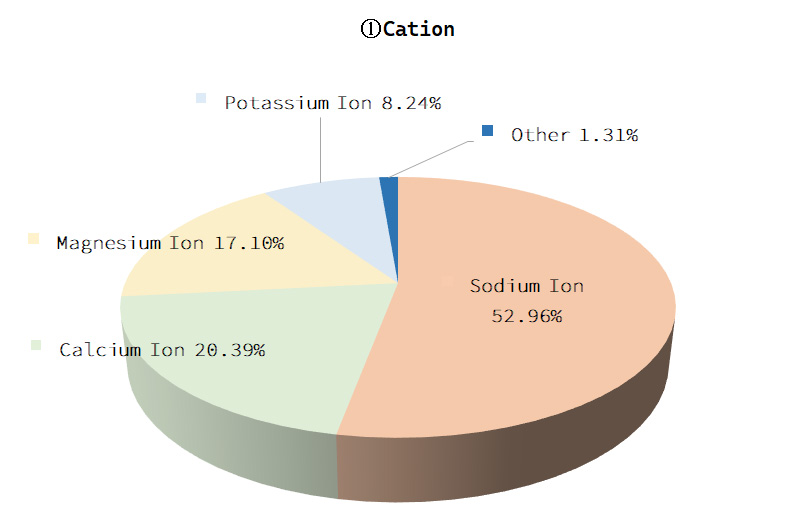 |
|||
|---|---|---|---|
| ①Cation | mg | mval | mval% |
| Sodium Ion (Na+)★ | 160.9 | 7.00 | 52.96 |
| Calcium Ion (Ca2+)★ | 54.0 | 2.69 | 20.39 |
| Magnesium Ion (Mg2+) | 27.5 | 2.26 | 17.10 |
| Potassium Ion (K+) | 42.6 | 1.09 | 8.24 |
| Manganese Ion (Mn2+) | 0.9 | 0.03 | 0.25 |
| Iron(Ⅱ) Ion (Fe2+) | 0.8 | 0.03 | 0.23 |
| Iron(Ⅲ) Ion (Fe3+) | 0.4 | 0.02 | 0.14 |
| Ammonium Ion (NH4+) | 0.4 | 0.02 | 0.15 |
| Lithium ion (Li+) | 0.4 | 0.06 | 0.48 |
| Strontium Ion (Sr2+) | 0.2 | 0.01 | 0.04 |
| Barium ion (Ba2+) | 0.1 | 0.00 | 0.01 |
| Cations Total(1) | 288.1 | 13.21 | 100.00 |
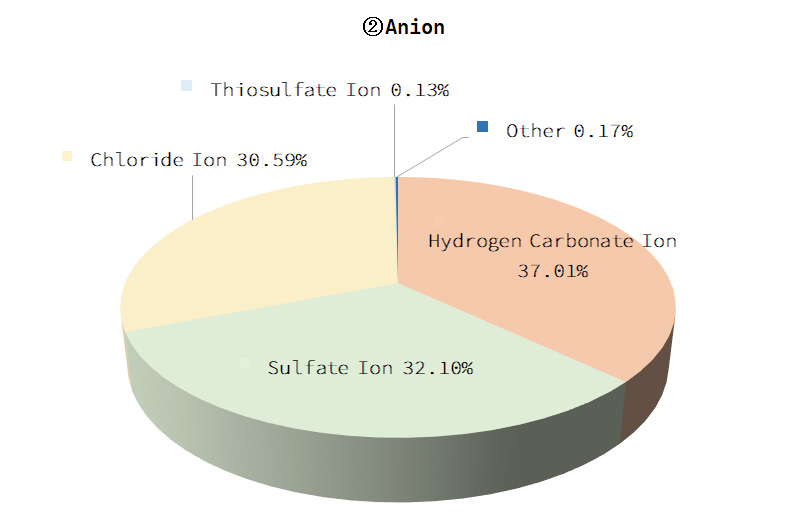 |
|||
|---|---|---|---|
| ②Anion | mg | mval | mval% |
| Hydrogen Carbonate Ion (HCO3-)★ | 288.8 | 4.37 | 37.01 |
| Sulfate Ion (SO42-)★ | 197.2 | 4.11 | 32.10 |
| Chloride Ion (Cl-)★ | 138.7 | 3.91 | 30.59 |
| Thiosulfate Ion (S2O32-) | 0.9 | 0.02 | 0.13 |
| Bromine Ion (Br-) | 0.7 | 0.01 | 0.07 |
| Fluoride Ion (F-) | 0.3 | 0.01 | 0.11 |
| Anion Total(2) | 626.7 | 12.79 | 100.00 |
| ③Undissociated Components | mg | mmol | |
|---|---|---|---|
| Metasilicic Acid (H2SiO3)★ | 251.4 | 3.22 | |
| Metaboric Acid (HBO2)★ | 9.7 | 0.22 | |
| Meta-arsenic Acid (HAsO2) | 0.1 | 0.01 | |
| Undissociated Components Total(3) | 261.1 | 3.44 | |
| Dissolved Gas Components | mg | mmol | |
|---|---|---|---|
| Free carbon dioxide (CO2) | 104.2 | 2.37 | |
| Free hydrogen sulfide (H2S) | Less than 0.1 | Less than 0.1 | |
| Dissolved Gas Components Total(4) | 104.3 | 2.37 | |
| Other Trace Components | |||
|---|---|---|---|
| Total arsenic 0.03 mg/kg, Hydrogen ion, Aluminum ion, Copper ion, Zinc ion, Total chromium, Hydroxide ion, Iodine ion, Hydrogen sulfide ion, Dihydrogen phosphate ion, Carbonate ion, Nitrate ion, Nitrite ion: Not detected |
★are the components related to the "spring quality" and the components that qualify conditions for "hot spring" and "therapeutic hot spring".
Indications by Spring Quality for Bathing (Revised on July 1, 2014)
Cuts, Peripheral circulatory disturbance, Sensitivity to cold, Depression, Dry skin
General Indications for Bathing (Revised on July 1, 2014)
Chronic pain or stiffness of muscles or joints (chronic phase of rheumatoid arthritis, osteoarthritis, lower back pain, neuralgia, frozen shoulder, bruises, sprains, etc.),
muscle stiffness by motor paralysis, sensitivity to cold, peripheral circulatory disturbance,
gastrointestinal hypofunction (slow digestion, intestinal gas formation, etc.),
mild hypertension, impaired glucose tolerance (diabetes), mild hypercholesterolemia,
mild asthma or emphysema, pains of hemorrhoidals, autonomic instability,
various symptoms from stress (sleep disorders, depression, etc.),
restorative phase from illness, recovery from fatigue, health promotions
Contraindications by Spring Quality for Bathing (Revised on July 1, 2014)
None
General Contraindications for Bathing (Revised on July 1, 2014)
Active stage of diseases (especially when fever is accompanied), active tuberculosis,
advanced malignant tumor, or the case of significant debility involving severe anemia,
severe cardiac or lung diseases involving suffocation feelings with a little movement,
severe kidney disease involving edema, gastrointestinal bleeding,
when there is visible bleeding, acute exacerbation stage of chronic diseases, etc.
Indications by Spring Quality for Drinking
Not drinkable
Date of Analysis (The above hot spring composition table is cited from the survey data of the following institution)
December 16, 2016 (Dojin Glocal Co. Ltd)
- ※Indications and contraindications for hot springs are in accordance with "Guidelines for the Mineral Spring Analysis Methods" revised on July 1, 2014.
- ※Data was provided by the ryokan.
20 qualifications for "hot spring" and 8 qualifications for "therapeutic hot spring"
| Conditions/Components (contained amount in 1kg) ※If even one of the conditions is cleared, it is a "Hot spring" or "Therapeutic hot spring" |
A【Hot Springs Act】 Conditions of the "Hot spring" |
B【The Guideline for analysis of Kosen】 Conditions of the "Therapeutic hot spring" |
|
|---|---|---|---|
| 1 | Temperature (when collected from source) | 25℃ or more | |
| 2 | Dissolved substances (excluding gaseous) | Total amount 1,000mg or more | |
| 3 | Free carbon dioxide (CO2) | 250mg or more | 1000mg or more(Carbon dioxide springs) |
| 4 | Lithium Ion (Li+) | 1mg or more | ― |
| 5 | Strontium Ion (Sr2+) | 10mg or more | ― |
| 6 | Barium Ion (Ba2+) | 5mg or more | ― |
| 7 | Total Iron Ion[Fe2+(Iron(Ⅱ) Ferro ion)+Fe3+(Iron(Ⅲ) Ferri ion)] | 10mg or more | 20mg or more(Iron containing springs) |
| 8 | First Manganese Ion (Mn2+) | 10mg or more | ― |
| 9 | Hydrogen Ion (H+) | 1mg or more | 1mg or more (Acidic springs) |
| 10 | Bromine Ion (Br-) | 5mg or more | ― |
| 11 | Iodide Ion (I-) | 1mg or more | 10mg or more (Iodine containing springs) |
| 12 | Fluoride Ion (F-) | 2mg or more | ― |
| 13 | Hydro Arsenate Ion (HAsO42-) | 1.3mg or more | ― |
| 14 | Meta-arsenic Acid (HAsO2) | 1mg or more | ― |
| 15 | Total sulfur (S) [HS-(Hydrogen sulfide ion)+S2O32-(Thiosulfate Ion)+H2S(Free hydrogen sulfide)] | 1mg or more | 2mg or more (Sulfur springs) |
| 16 | Metaboric acid (HBO2) | 5mg or more | ― |
| 17 | Metasilicic acid (H2SiO3) | 50mg or more | ― |
| 18 | Bicarbonate soda (NaHCO3) | 340mg or more | ― |
| 19 | Radon (Rn) | 20 or more (unit: ten ppb curie) 20×10-10Ci(curie) or more 20 or more(ten ppb curie) =74Bq(becquerel) / 5.5mache or more |
30 nanocurie or more (Radioactive springs) 30×10-10Ci(curie) or more 30 or more(ten ppb curie) =111Bq(becquerel) / 8.25 macheor more |
| 20 | Radium salt (as Ra) | 10-8mg or more 1/100 million mg or more |
― |
| Number of conditions cleared this "hot spring" or "therapeutic hot spring" is: | 5 (out of 20) | 2 (out of 8) | |
| Total 7 Points | |||
Hot Spring Legends and More
Traditionally documented efficacies
ー
Historical figures who bathed in this hot spring
Haiku poet Takano Soju (1893-1976)
Celebrities who bathed in this hot spring
Numerous cultural and celebrity visitors, not mentioned due to private use
Hot Spring (Onsen) Report
Fumoto Ryokancurrently uses a private hot spring source located on the premises of its sister inn, Ryokan Kounoyu.
The distance from the wellhead to the inn is approximately 500 meters, a distance considered short enough to
maintain the freshness of the hot spring water. Drawn from a depth of 300 meters underground, the hot spring boasts
a mineral-rich quality with abundant beneficial components.
The spring water emerges at a temperature of 60.5℃ . To maintain a comfortable bathing temperature (40‒42℃),
water is not added as much as possible. Instead, the temperature is adjusted using heat exchangers and by controlling
the volume of water flowing into the baths. While most modern hot spring facilities manage water temperature
through computerized systems, here, it is done by hand. This dedication to preserving the hot spring’s quality is truly
admirable.
According to the Hot Spring Analysis Reports, the dissolved substances (excluding gaseous substances), which are the
active components of the hot spring, are 1,180 mg/kg. Since this exceeds 1,000 mg/kg, the spring qualifies as a “saline spring”, and the main components are listed in the spring quality name.
That spring quality name is: Sodium, Calcium‒Hydrogen Carbonate/Sulfate/Chloride Spring.
Yes, it’s a long name, but it serves as proof of the variety of characteristics of the hot spring. Simply put, it’s a unique
blend of 3 spring qualities: hydrogen carbonate spring, sulfate spring, and chloride spring.
Let’s look at each in more detail.
1. Hydrogen Carbonate Spring
When sodium ions, the most abundant cation, and hydrogen carbonate ions, the most abundant anion, are combined,
the result is a Sodium‒Hydrogen Carbonate Spring (formerly known as “Sodium Bicarbonate Spring”).
Hydrogen carbonate softens the outer layer of the skin, making it easier to remove dead skin cells. This leaves the skin
smooth and is why it’s often called “Hot springs for beautiful skin” with cleansing effect.
In addition, it is also called “Hot springs for refreshing” or “Hot springs for cooling effect”, because the skin's
protective power is weakened by the reduction of sebum, making it easier for moisture on the surface of the skin to
evaporate, and bathing in it, especially during hot weather, provides a refreshing feeling afterwards.
Hydrogen carbonate ion also enhances the cleansing effect on the skin and promotes disinfecting and sterilizing
action on wounds, supporting healing for cuts.
It also promotes the removal of dead skin cells while retaining moisture, which helps with dry skin as well.
Furthermore, the carbon dioxide (CO₂) contained in the product is absorbed into the body through the skin, dilating
peripheral blood vessels and improving blood flow, which has an effect on peripheral circulatory disturbance. As blood
flow increases, symptoms of sensitivity to cold are alleviated.
2. Sulfate Spring
When calcium ions, the second most abundant cation, and sulfate ions, the second most abundant anion, are
combined, the result is a Calcium‒Sulfate Spring (formerly known as “Gypsum Spring”).
This sulfate spring is called “Hot springs for anti-aging” because of its skin reviving and wrinkle stretching effects
, and like “Sodium - Hydrogen carbonate spring (Sodium bicarbonate spring)”, it is also called “Hot springs for beautiful
skin”. Furthermore, it is also known as “Hot springs for cuts” because of its ability to revive the skin. In addition,
calcium ions have the effect of adjusting the contraction and dilation of blood vessels, stabilizing blood pressure and
having a calming effect, and sulfate ions have the effect of dilating blood vessels, making them good for hypertension
and arteriosclerosis, and “Calcium‒Sulfate springs” are also called “Hot springs for strokes
”.
The indications by spring quality of sulfate springs include the same 4 items as hydrogen carbonate springs (cuts,
peripheral circulatory disturbance, sensitivity to cold, dry skin
), with the addition of depression.
3. Chloride Spring
The third spring quality is the Sodium‒Chloride Spring (formerly known as “Weak Salt Spring”).
Salt forms a thin layer over the skin’s sweat glands, preventing evaporation of sweat and helping the body retain
warmth after bathing. Because of this effect, it is commonly referred to as “Hot springs for warmth
”.
The long-lasting heat-retention effect promotes balance in the autonomic nervous system and contributes to
emotional stability. Additionally, by raising the body temperature, it may suppress the secretion of stress hormones
and improve mood, showing potential benefits for depression
.
Furthermore, because it coats the skin, it works excellently as “Hot springs for finishing touch” after bathing in “Hot
springs for beautiful skin”, locking in moisture and enhancing hydration.
Due to the salt’s bactericidal properties, it is also known as “Hot springs for cuts”.
In summary, the indications by spring quality of chloride springs match those of sulfate springs: cuts, peripheral
circulatory disturbance, sensitivity to cold, dry skin and depression
.
In addition to having the benefits of all 3 spring qualities, this hot spring has a neutral pH of 6.4, making it gentle and
low-irritant—perfect for sensitive skin.
Let’s take a closer look at the sodium ions and hydrogen carbonate ions.
When their combined milliequivalent percentage exceeds 80%, the water is said to have a “silky-smooth” texture. This
spring contains 52.96% sodium ions + 37.01% hydrogen carbonate ions, totaling 89.97%, so guests will truly feel the
smoothness when they bathe.
Furthermore, the amount of sodium hydrogen carbonate (also known as sodium bicarbonate)—a key indicator of hot
spring quality—is 397 mg/kg, which surpasses the legal threshold of 340 mg/kg to qualify as an official hot spring.
The hot spring also contains 251.4 mg/kg of metasilicic acid, a non-dissociating moisturizing component. This
amount is more than 5 times the standard value for hot spring, and in this respect can also be called “Hot springs for
beautiful skin”.
Additionally, the spring contains 9.7 mg/kg of metaboric acid, which is known for its strong cleansing effects. This
exceeds the 5 mg/kg threshold to qualify as a hot spring, and had it surpassed 10 mg/kg, it could be called “Hot
springs for beautiful skin”.
What makes this experience even more special is that the spring water is delivered directly from the source without
circulation—a luxurious kakenagashi style—allowing guests to fully feel the natural benefits of the spring on their
skin.
One of the reasons this inn is so beloved is its use of an abundant private hot spring source, offering guests 3 types of
open-air baths: public open-air baths, private open-air baths, and guest room open-air baths that can be enjoyed at
any time of day, at your own pace.
| Private bath "Tachiyu" | Open-air bath "Momiji-no-Yu" |
|---|---|
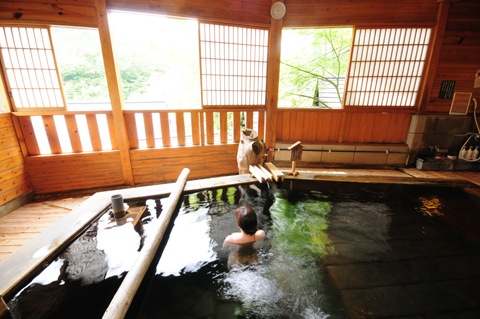 |
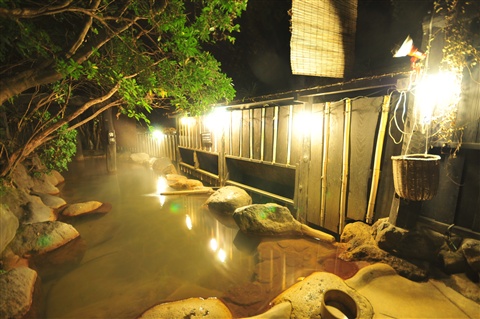 |
| It is the largest of the private baths. The depth increases as you move from the front to the back, reaching a maximum depth of 150 centimeters, and you can stretch your legs by holding onto the wooden pillar in the center. Stretching your arms and legs to the fullest in a natural, comfortable posture puts no strain on your back or knees. | The open-air bath "Momiji-no-Yu" is basically for men, but from 9:00 p.m. to 10:00 p.m. it is for women only. Bathing while listening to the murmuring of the Tanohara River that flows below the open-air bath will provide a strong tipping point effect. |
| Private bath "Ichi-no-Yu" | Private bath "Go-no-Yu" |
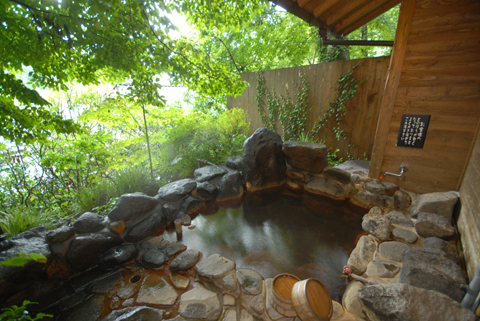 |
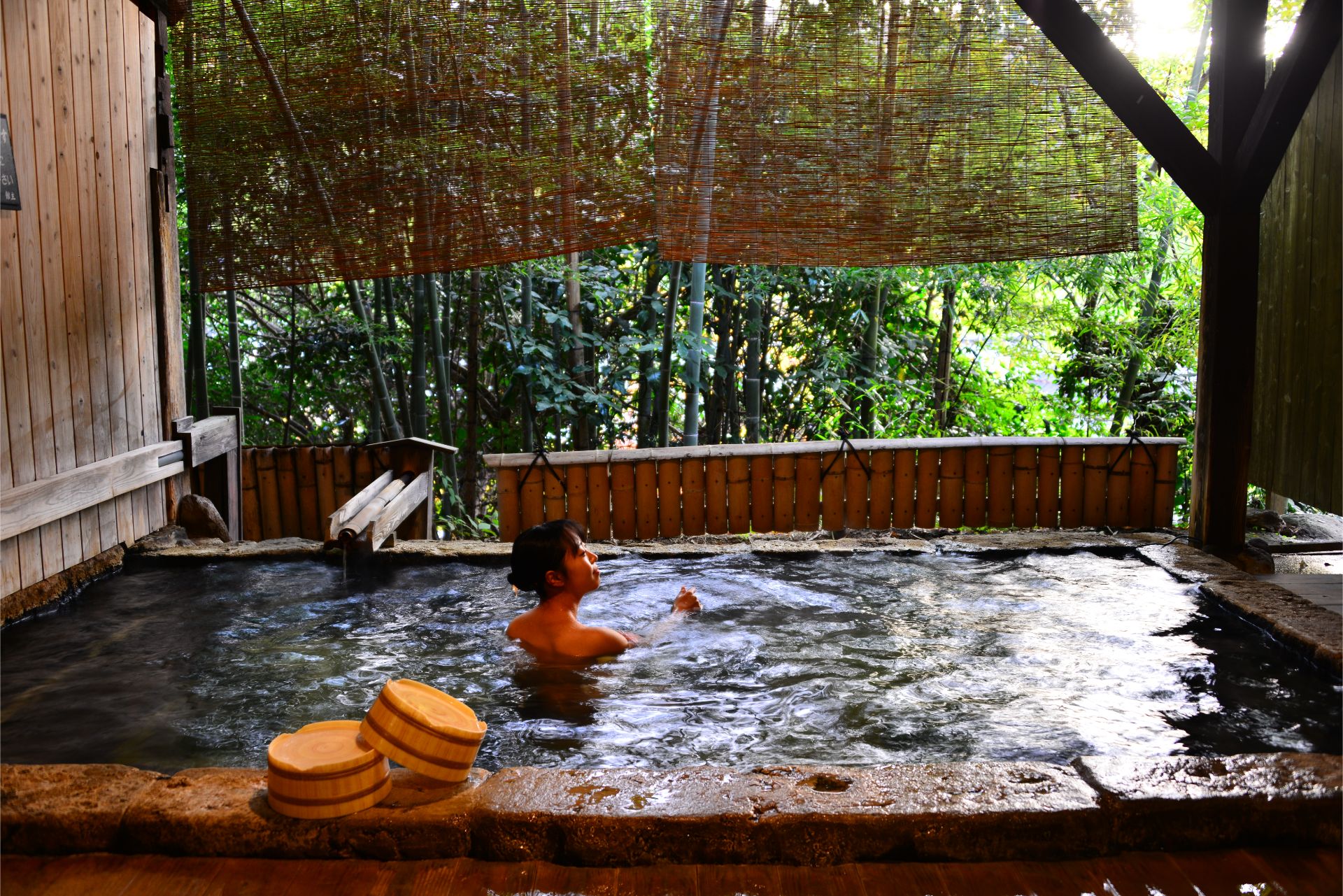 |
| The bathtub is constructed of stone and stands on a slope, providing an excellent view. It is interesting to note that the thriving trees provide just the right amount of shade. | The private baths are full of the atmosphere of the outdoors. Although not as large as the standing baths, small groups can enjoy a relaxing soak in the baths. Of course, the source of the water is free-flowing. |
Facility Report
Kurokawa Onsen in Kumamoto Prefecture is now playing a textbook role for all hot spring areas in Japan. Although it is a small hot spring resort located in the mountains, the individuality of each hot spring area is not compromised, and yet the overall impression of the hot spring area is one of uniformity.
As a finishing touch, Kurokawa Onsen sold "Onsen hopping pass" that allowed visitors to bathe in three baths for the purchase of one bill, and led visitors to tour the entire hot spring area while wearing yukata, which became very popular.
The entire town was captured as a single onsen ryokan, giving it a sense of unity, which won the sympathy of onsen fans.
It was the president and landlady of Fumoto Ryokan who came up with the idea for the "Onsen hopping pass", which is now commonplace in hot spring areas throughout Japan.
The inn is located on Kawabata-dori, the main street of Kurokawa Onsen, and has a total of 17 baths (2 open-air baths for men and women, 11 private baths including open-air baths, 3 open-air guest baths, and 1 footbath) for a total of 14 guest rooms, making it a true department store of hot springs.
The guest rooms are mainly rustic Japanese-style rooms, but there is also a guest room with an open-air bath and a bed in the annex.
The cuisine includes Kumamoto's famous horse sashimi and Higo beef, and is reasonably priced, so everything is highly rated.
You can truly feel the reason for the nationwide popularity of Kurokawa Onsen at this inn.
Travel Journal
Rates Data
| 1 night/2 meals fee | From 16,650 yen (tax included) |
|---|---|
| 1 night/Breakfast fee | From 11,150 yen (tax included) |
| Stay without meals | No settings |
| Staying alone | From 16,650 yen (tax included) |
| Private bath fee when overnight stay |
Free |
| Day stay | Available with the purchase of "Onsen hopping pass" ¥1,500 (tax included) |
| Private bath for day-stay |
No settings |
Facility Data
| Establishment | 1955 |
|---|---|
| Check-In | 3:00 p.m. |
| Check-Out | 10:00 a.m. |
| Location and Environment | Hot spring area |
| Number of Rooms | All 14 rooms (Japanese-style room 11/Japanese-Western style room 2/Western-style room 1) |
| Number of People Accommodated |
50 persons |
| Parking Area | Available for 20 cars |
| Facilities | Banquet hall, Shop |
| Internet | Wi-Fi available |
| Barrier Free | Not supported |
| Toilet with washer | Equipped |
Transportation Access
| By bus | ○From Fukuoka: Express buses are available via Hakata Station, Tenjin Station, and Fukuoka Airport (Nishitetsu Express Bus) ○From Kumamoto: Highway buses available via Kumamoto Station, Aso Kumamoto Airport, and Aso Station (Trans Kyushu Bus) ※For Trans Kyushu Bus, there are two types of buses: one includes sightseeing in Aso and the other does not. Also available from Beppu area. ※Sanko Bus is also available from Kumamoto area. Nishitetsu Express Buses are available for Hita Station (many services, transfer at Hita Station) and for Tsuetate Onsen (few services). |
|---|---|
| Shuttle bus | None |
| By car | Exit at the Hita Interchange or Yufuin Interchange on the Oita Expressway or at the Kumamoto Interchange on the Kyushu Expressway. |
| Address | Kumamoto / Kurokawa Onsen / FUMOTO RYOKAN 6697 Manganji, Minami-Oguni machi, Aso-gun, Kumamoto, 869-2402, TEL: +81-967-44-0918 |
- Data
- Dec. 4, 2024

